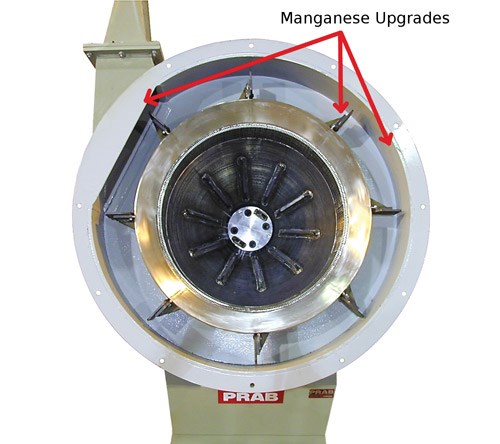Wear Abatement Strategies for Capital Equipment
The machining industry, like many other manufacturing market segments, has been forced to scrutinize capital equipment purchases in an effort to squeeze the most from a tight capital project budget with short expected returns.
The machining industry, like many other manufacturing market segments, has been forced to scrutinize capital equipment purchases in an effort to squeeze the most from a tight capital project budget with short expected returns. Often, pre-project planning and equipment evaluation do not take into account the long-term operational effects of rugged operating conditions, faster machining times, material alloys with challenging compositions and varying material quality from global sourcing options. Manufacturing optimization and production time can be compromised if operational factors and wear strategies are not part of the upfront equipment evaluation discussions.
Good industrial equipment design will build in a safety factor for operational wear; however, specific application and production details should be shared with the equipment design engineer to gain the best value and longest equipment life. Wear abatement strategies are especially important when selecting metal scrap handling equipment.
Physics and experience tells us where and how a particular part will erode over time. Various wear resistant materials provide specific advantages, but may have drawbacks in other functional areas. Knowing exactly what material the equipment will be running is the key to a durable installation.
Upfront communication of factory conditions, and concerns and constraints are vital to long-term service life and unplanned downtime. Critical application data to provide the design engineer for metal scrap handling equipment are: the specific alloy(s) to be handled; metal chip geometries, densities and abrasiveness expected; how equipment will be fed (continuous or batch); specific cutting fluid(s) and volume; actual normal process rate (lbs/hr.); maximum surge or instantaneous rate (lbs/hr.); and frequency and description of bar ends, parts or tramp metal in the chips.
The data provided will give the equipment engineer enough detail to deliver the correct level and placement of wear resistance for the application while deploying realistic, cost effective recommendations.
Metal chip wringers employ many of the various wear abatement strategies. These units extract cutting fluids from machine shop scrap by exposing the chips to 600 Gs of force at the separation screen.
Given today’s alloys and production rates, wringer components are subject to severe sliding and impact abrasion, depending on their position in the machine and the characteristics specific to the scrap being processed. To compound the issue, wringer parts need to be formed, cut or machined to produce the unit. Here are specific strategies to protect a chip wringer in an extreme wear application:
- Make sure the basic unit is designed for replaceable and upgradable wear surfaces: liner, air paddles, screen, top cover and discharge housing.
- Extensive use of AR (abrasion resistant) steels to combat wear such as sliding friction across the formed liner should be used.
- Special hard surfacing, welding electrodes are used to create a very hard surface that is applied to specific areas, such as protection of structural welds, impact zones and specific surfaces of the liner and accelerator vanes on harsh applications.
- Using upgraded wringer screen material adds life to the critical separation area of the unit (Grade 1 screen).
- A manganese steel top cover, discharge housing, air paddles, and impact ring will work harder to combat the effects of both sliding and impact wear.
- For air discharge-style wringers, nickel hardened castings are used to construct the square to round discharge transition and vibration isolation joints as well as bends for pneumatic discharge piping.
Scrap metal handling equipment requires strategic uses of specialized materials to produce a rugged design. An economic balance between initial cost and durability creates scrap recovery equipment with a low total cost of ownership.
Ignoring durability in today’s high volume, special alloy environment potentially means a loss of production because of unscheduled downtime or replacement of equipment after a long battle to keep it running. When planning the purchase of metal scrap or cutting fluid separation equipment, it’s critical to take into account an application-specific wear abatement plan to ensure the investment is sound. Help is available at the earliest stages of a project to ensure the correct equipment is specified to do the job over time.
Related Content
Strengthening Manufacturing Workplaces Through Active Listening
A good strategy to weather the storms of manufacturing market upheavals and unpredictable factors is to commit to continuous, active employee listening.
Read MoreEmerging Leader's Problem-Solving Skills Cool Down a Hot Project
This 2023 Emerging Leader developed a product in response to a call for help from Yamaha that was a huge hit in the snowmobile industry when it hit the market in 2010. In fact, it is now a common product that most snowmobile OEMs have implemented.
Read More4 Tips for Building an Effective Machining Apprenticeship Program
Developing the right apprenticeship program can be one of the best things a machine shop can do for itself and for the future of manufacturing. Here are key “do’s” and “don’ts” to follow.
Read MoreEmerging Leader's Dedication to Education
Instilling confidence throughout a shop floor can do wonders for company morale while increasing productivity.
Read MoreRead Next
Integrated Solutions for Chip Removal and Fluid Filtration
Shops can easily view chips simply as waste, hardly giving a second thought to the disposal process and the potential related savings. By keeping an eye on the waste and choosing the most efficient methods of chip disposal, a shop can easily add to the bottom line through substantial savings.
Read MoreSeeing Automated Workpiece Measurement in Real Time
User-friendly inspection software for CNC machining centers was shown at IMTS 2024 monitoring measurements between and after machining while performing SPC based on recorded measurement values.
Read MoreDo You Have Single Points of Failure?
Plans need to be in place before a catastrophic event occurs.
Read More










.jpg;maxWidth=300;quality=90)













